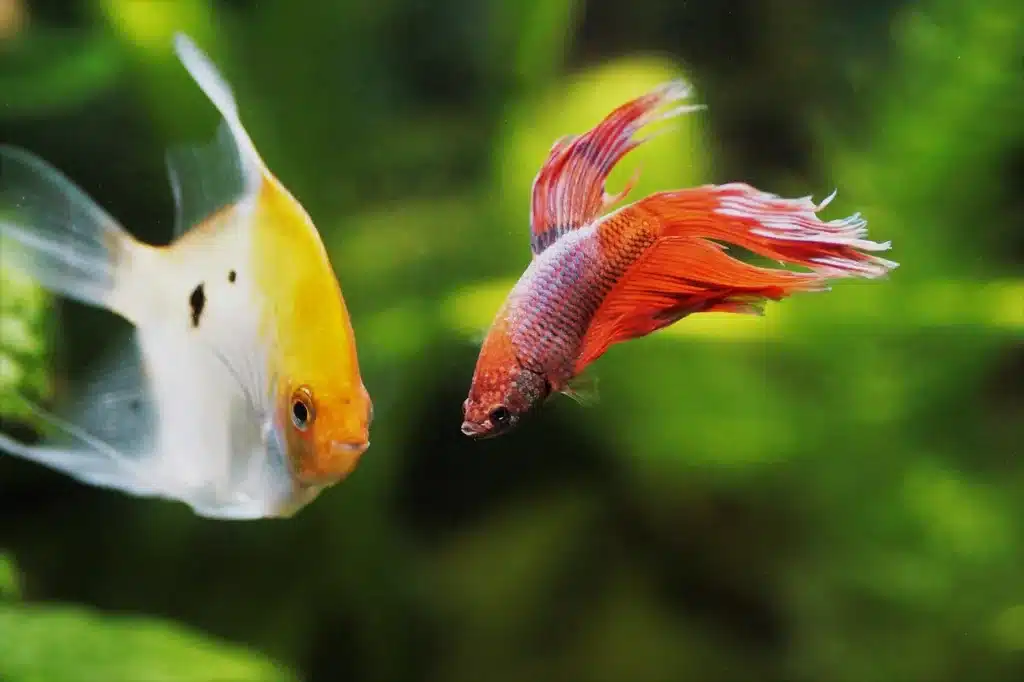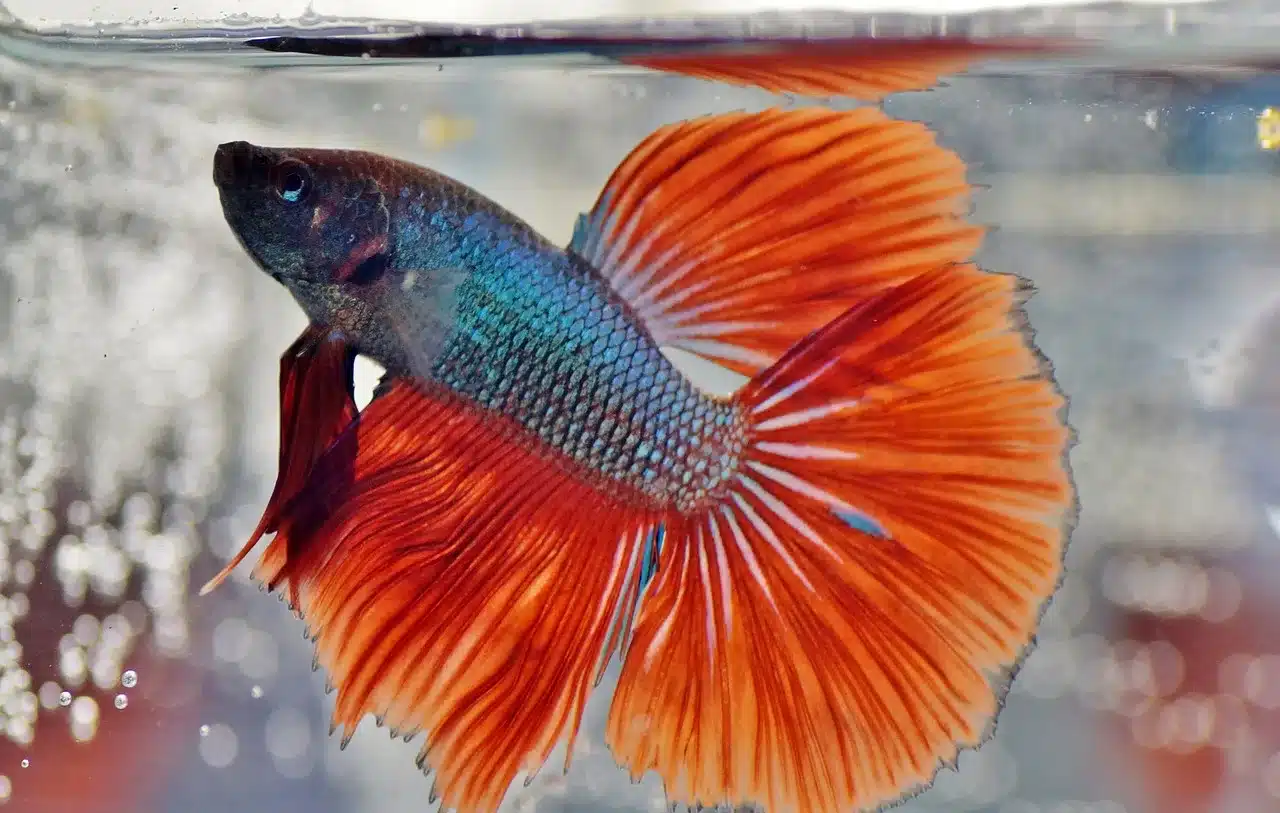Ever stumbled out of bed, checked on your fishy friend, and gasped to see their fins looking like they’ve been through a paper shredder? It’s heart-wrenching, I know. When you find your Betta fins shredded overnight, a million questions start buzzing through your mind. What happened? Why did this happen? And most importantly, what can you do about it?
I’ve been there, and trust me, figuring this out is crucial not just for your Betta’s beauty but for their health, too. Stick around as we dive into why this happens and explore some effective treatments to help your Betta heal and thrive. Let’s make those fins fabulous again!
Possible Reasons Betta Fins Shredded Overnight?
When you notice your Betta fins shredded overnight, it’s essential to pinpoint the cause to address the problem effectively. Here are some of the most common reasons why this might happen:
- Fin Rot
Fin rot is one of the top culprits for damaged Betta fins. A bacterial infection usually strikes when water conditions are less than ideal. Suppose your tank’s cleanliness needs to be better. In that case, harmful bacteria can thrive and attack the delicate tissues of your Betta’s fins. The edges of the fins often look discolored (black or white) and ragged, as if they are literally rotting away.
- Aggression from Tank Mates
Bettas are known for their feisty, territorial nature, but they can also be the recipients of aggression, especially if they share space with the wrong tank mates. Some fish might nip at the Betta’s long, flowing fins out of aggression or mere curiosity, which can suddenly leave the fins looking torn and tattered.
- Self-Inflicted Injury
The stress or boredom sometimes leads Bettas to nip at their own fins. This can be triggered by a lack of stimulation in the tank (like too little space or insufficient hiding spots), reflection-induced stress (thinking their reflection is another Betta), or even poor water conditions. The damage often appears symmetrical and may look like uniform cuts or tears in their fins.
- Environmental Factors
Sharp or rough edges on decorations or substrates can also pose a risk to Betta fins. As they glide and swoop through the water, delicate fins can easily catch and tear on unpolished surfaces. It’s like snagging your sweater on a bramble—sudden and unwanted.
- Water Quality Issues
Poor water quality is a significant stressor for Bettas. It can lead to a host of health problems, including fin damage. High toxins like ammonia or nitrite, improper pH levels, and fluctuating temperatures can weaken your Betta’s immune system and make their fins more susceptible to diseases and physical damage.

How Can I Tell if My Betta’s Fins Are Damaged Due to Aggression from Other Fish?
Identifying if your Betta’s fins have been damaged due to aggression from other fish involves some detective work. Here’s how you can figure it out:
Observe Tank Dynamics
Spend some time watching how the fish interact in the tank. Aggressive behavior from tank mates can often be seen before actual damage occurs. Look for signs like chasing, nipping, or other fish cornering your Betta. Aggressive tankmates usually target the flowing fins of the Betta, leading to visible tears and rips.
Examine the Physical Damage
Damage from aggression usually appears as jagged or irregular tears along the fins. Unlike rot or decay, which tends to affect the edges of fins gradually, damage from bites often looks more like chunks missing or uneven shredding. The damage might also be more severe towards the back of the fins, where other fish can quickly grab them.
Check for Stress Indicators
Besides the physical appearance of the fins, stressed Bettas might display other behaviors indicating discomfort from aggression. This includes hiding excessively, attempting to escape the tank, or reduced feeding. A stressed Betta might also clamp its fins close to the body rather than holding them spread out beautifully.
Monitor the Betta’s Recovery
If you suspect that aggression is the cause and take steps to separate the Betta or remove the aggressive fish, you should notice an improvement. Healing fins will gradually look cleaner and regrow if attacks no longer stress the Betta. If the fin damage were due to aggression, you would also observe that no new damage appears once the aggressive tank mate is removed or conditions are altered.
Could the Damage Be Self-Inflicted?
Sometimes, the damage to a Betta’s fins could indeed be self-inflicted. This phenomenon, known as fin-nipping, occurs when a Betta bites its fins. Here are some key points to consider when determining if the damage might be self-inflicted:
Reasons for Self-Mutilation
Self-inflicted fin damage can stem from several factors:
- Stress: Betta fish can exhibit this harmful behavior at high-stress levels. Stress can be caused by poor water conditions, inadequate space, excessive brightness, or lack of environmental enrichment.
- Boredom: Bettas are intelligent and need mental stimulation. A lack of visual variety and environmental enrichment in the tank can lead to boredom, which can result in the Betta turning to fin-nipping as a form of self-stimulation.
- Reflections: In some cases, Bettas may perceive their own reflections in the glass as a rival Betta, leading to aggressive displays and fin-nipping as they attempt to challenge the “intruder.”
Identifying Self-Inflicted Injuries
To determine if fin damage is self-inflicted, look for the following clues:
- The pattern of Damage: Self-inflicted fin damage often appears more symmetrical and clean-cut than the jagged tears caused by aggression or environmental factors. The Betta may bite off pieces of its fins, resulting in a rounded or even pattern, especially near the fins’ tail or tips.
- Betta’s Behavior: Observe your Betta’s behavior. If you catch the fish turning to bite its own tail or fins, that’s a clear indicator of self-inflicted damage. Betta fish engaging in this behavior might appear restless or agitated.
Preventing Self-Inflicted Damage
If you suspect that your Betta is nipping its own fins, consider the following preventive measures:
- Improve Tank Environment: Enhance the tank with more plants, hiding spots, and varied decorations to stimulate and reduce stress.
- Adjust Tank Conditions: Check and adjust water parameters like temperature, pH, and cleanliness to ensure they are within optimal ranges for Betta’s health.
- Reduce Reflections: If reflections are causing the Betta to become aggressive with its image, try altering the lighting or adding a background to the outside of the tank to minimize reflections.
- Monitor and Modify: Keep closely watching your Betta after making environmental changes. Improvement in fin condition and overall behavior can help confirm if the issue was self-inflicted and if the changes are effective.

How To Treat Shredded Fins?
Treating shredded fins in Bettas requires a careful approach to ensure proper healing and prevent further damage. Here’s how to treat shredded fins depending on the underlying cause:
- Address Environmental Causes
If the shredding is due to poor water quality or harmful tank conditions:
- Water Quality: Perform immediate water changes to improve the water quality. Regularly check and adjust water parameters such as ammonia, nitrites, and nitrates, keeping them safe (ammonia and nitrite at 0 ppm, nitrates less than 20 ppm).
- Remove Sharp Objects: Inspect the tank for any sharp or abrasive decorations or substrates that could be causing physical damage to the fins. Replace them with smoother, safer options.
- Treat for Disease or Infection
If fin rot or another infection is suspected:
- Medication: Consult a veterinarian or a knowledgeable aquarist for appropriate antibacterial or antifungal treatments. Medications like Maracyn or Fungus Cure can be effective against fin rot.
- Salt Baths: Consider mild salt baths using aquarium salt to help prevent infection and aid healing. Dissolve a small amount of aquarium salt in a separate container of tank water before gradually introducing the Betta to the solution for short periods.
- Manage Aggression
If tank mates cause injuries:
- Separation: Immediately isolate the Betta from aggressive tank mates. Move the Betta to a separate tank or rearrange/repopulate the community tank to prevent further attacks.
- Monitor and Adjust Tank Dynamics: Ensure the tank is spacious enough to comfortably accommodate all inhabitants and provides plenty of hiding spots to reduce stress and aggression.
- Address Self-Inflicted Injuries
For fins damaged by self-nipping:
- Environmental Enrichment: To enrich your Betta’s living space, improve the tank environment with more plants, hiding spots, and appropriate tank decorations.
- Reduce Stress Factors by Modifying lighting, providing a calm environment, and ensuring the tank setup doesn’t produce aggravating reflections.
- Supportive Care
General care to support fin healing includes:
- Optimal Water Conditions: Maintain a clean tank with stable water temperatures suitable for Bettas (around 76 to 80 degrees Fahrenheit) and pH levels (around 7.0).
- Good Nutrition: Feed a high-quality, varied diet to ensure your Betta gets all the necessary nutrients to support immune function and repair.
- Monitor Healing: Keep an eye on the fins as they regenerate. Healthy new growth typically appears clear or slightly lighter in color at first.
- Prevent Future Incidents
Once your Betta’s fins are healing, take steps to prevent future damage:
- Regular Maintenance: Keep up with regular tank maintenance, including routine water changes and filter cleaning.
- Ongoing Observation: Continually monitor the behavior of your Betta and its tank mates to catch any potential issues early.
How Long Will It Take for the Fins to Heal?
The healing time for shredded Betta fins can vary widely depending on the severity of the damage and the cause. Here’s what you can typically expect:
- Minor Tears: Minor fin damage with small tears or nicks can heal quite quickly, often improving within a couple of weeks. These minor injuries typically heal without leaving much scarring.
- Moderate to Severe Damage: In cases of more significant damage, such as large portions of the fins being torn or severe fin rot, the recovery process can take several weeks to months. As the fins regenerate, new growth appears translucent or slightly colored at the edges, gradually filling in over time.
- Continuous Monitoring: It’s crucial to monitor the healing process for any signs of infection or halted growth. Improvements should be gradual but steady. If the fins are not regenerating or the condition worsens, further investigation and potentially different treatments may be needed.
Conclusion
Finding your Betta fins shredded overnight can be a distressing experience, but understanding the possible causes and appropriate responses can help you take swift and effective action. Whether the damage is due to environmental factors, aggression from tank mates, disease, or self-inflicted injuries, each scenario requires a specific approach to treatment and prevention. By improving the tank environment, treating any infections, managing stress, and ensuring high-quality water conditions, you can help your Betta’s fins heal and prevent future incidents.
Remember, the health of your Betta’s fins is a good indicator of their overall well-being and the quality of their environment. Regular observation and maintenance are crucial to prevent issues before they start. With proper care and attention, your Betta can recover fully and continue to thrive in their aquatic home, proudly displaying their beautiful, flowing fins.
